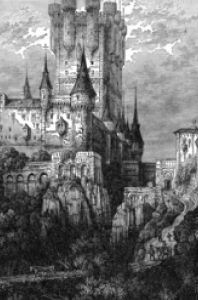Where the Moraga name came from appears open to much speculation/debate.
The earliest mention includes a Roman army belonging to a General Moraga dating back to the era of Emperor Honorio (393-423 A.D.)
Some sources attribute the name to an old lineage from Catalonia in Spain, while other sources attribute Basque, Andalusian and Castilian origins to the name.
There is even a story of a Spanish solder (Alonso Ortunez), who is reported to have beheaded a Moorish chieftain in the city of Baeza in Andalusia circa 800 A.D. He is said to have taken the name Mor Agha (Moorish chieftain), with a somewhat gruesomely appropriate family crest featuring the head of a Moor.
Somewhere along the way, the Moraga family adopted another coat-of-arms consisting of a tree (oak or mulberry), a helmet with horns and a silver border decorated with ermine tails.
The tree in the coat-of-arms seems especially appropriate with the family roots firmly in Spain, branching out to the New World.
The Moraga name has various meanings.
The surname “Morga” may be come from the Basque word for “oro,” which means bracken or fern. There is even a city on the coast called Morga. “Aga” can found in a number of Basque place names like Arrigorriagakoa or Urberoaga, basically meaning an abundance of.
Moraga could also be a variant of the name “Moragas,” which can be found in a few of genealogical entries.
In Spain, there are two possible origins, including the Spanish word for “mora” or “mulberry bush.” In Spain there is also it’s Arabic origin — “barbecue.” As a result, on the eastern coast there is an event known as “The Night of La Moraga,” which includes a traditional fire of driftwood buried in the sand to grill on skewers such seafood as sardines and prawns.
Arias Moragas is reported to have taken part in the Batalla de las Navas de Tolosa north of Baeza in the province of Jaén in Andalucia on 16 July 1212, a battle that helped the Christains drive the Moors out of much of Southern Spain. Calle Moraga is located in Baeza.
Circa 1229, it is said that King Don Jaime I of Aragón was accompanied by Don Guillén and Don Rodrigo de Moragas in the conquest of the island of Majorca off the eastern coast of Spain.
The Moragas were apparently not done with the conquest of Majorca, with a Beltran de Moragas serving with Pedro IV of Aragon in driving out James III from the island in 1343.
Doña Rosas Moragas, born in Barcelona, married Salvador de Fagos (date unknown).
Luis de Moraga was born in Barcelona, Catalunya, Spain in 1398. He was the father of Juan de Moraga y Galindez and grandfather of Bernardino de Moraga (See below).
The discovery in 1492 of the New World by Christopher Columbus (or the discovery of Christopher Columbus by the inhabitants of the Western Hemisphere) sparked a migration of those seeking to improve their family fortunes in the New World.
Extremadura in west central Spain is known as the “Cradle of the Conquistadors,” the home turf of such explorers as Francisco Pizarro (conquest of the Incas) and Hernán Cortés (conquest of the Aztecs). One of the major cities in this area is Cáceres, which happened to be the home at the time of a branch of the Moraga family. Sources indicate that it was from here and elsewhere in Southern Spain that the first Moragas sailed from Spain to seek their fortune in the New World
Bernardino de Moraga, who was born in Cáceras in 1475, was the father of Hernando de Moraga Galindo y Gomez, who immigrated to Peru in the 1830s.
Gaspar Moraga y Nidos, son of Benito Moraga y Nidos and Doña Maria de Carvajal, emigrated to New Spain circa 1570.
While several members of the Moraga family journeyed to the New World, other family members remained in Cáceres.
Benito Moraga y Nidos and Doña Maria de Carvajal lived in what became known as el Palacio – Casa de los Moraga.
Also remaining in Cáceres were Gonzalo Moraga and his sister, Jimena Gómez de Moraga, who are believed to have lived in the city during the mid-15th century. One source said the family at the time were members of the city council and among the wealthiest and more important families in the region.
The Cáceras branch of the Moraga family eventually died out during the 17th century.
Dona Marta de Moraga, reported to be the last of the Moraga line, donated el Palacio – Casa de los Moraga as a rectory to the Convent of Santa Maria de Jesus. The house, which is now a center of Extremaduran arts and crafts, can be seen today with an inscription outside reading “Casa de Nuestra Senora y Pobres Que Fue de los Moraga.”
The Moraga name continues to live on today in other parts of Spain.

